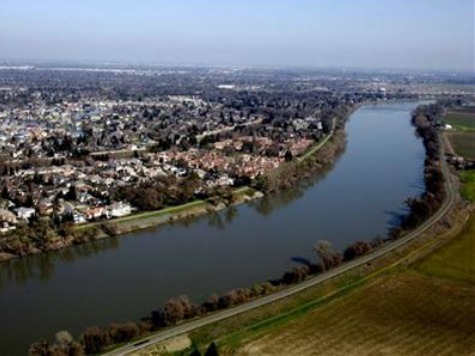
Kern County Water Agency intends to rescue hundreds of farms from the state’s severe drought this spring by reversing the flow of the California Aqueduct. Water districts in the San Joaquin Valley are proposing a drought tactic that’s never been tried: they want to reverse the state’s plumbing by running the California Aqueduct backwards.
A few months ago, drought conditions were so bad that it was expected the California Water Project would be forced to cut agriculture water allocations to 0%, in order to protect native species of fish and fauna along a 47 mile stretch of the state’s aqueduct. Management and engineers at the Kern County Water District decided to think “out of the box” by applying for the right to rent be up to 6 giant pumps to reverse the flow so that the district could still take water without killing the fish.
On February 5, the California Department of Water Resources (DWR) announced that no water would be delivered to its 29 public water agency customers–a first in the Project’s 54-year history. These deliveries along the 40 miles of canals help supply water to 25 million Californians and roughly 750,000 acres of irrigated farmland in the southern part of the state. The Northern California agricultural district suffered a 50% cut.
The current drought continues to break records statewide that were established in the severe drought of 1976-1977. Thirty-seven years ago Jerry Brown’s first Gubernatorial Administration was forced to declare a water emergency.
Early settlers’ accounts of the state’s agriculture rich Central Valley are laden stories of feast and famine. For example: a dry Sonoma was declared entirely unsuitable for agriculture and the Sacramento Valley was written off as “a barren wasteland” in 1841. But two decades later the Central Valley was described as a great “inland sea” during the torrential floods of 1861-1862. Two years later the area was devastated by drought.
The Dust Bowl droughts of 1928-1935 stoked a desire for water-moving and storage on an even grander scale, and saw the design and construction of the federal Central Valley Project system of canals, pumps and aqueducts. Later, the multi-year droughts of 1947-1950 and 1959-1960 (as well as some extreme floods in the intervening years) helped to justify investment in the State Water Project, which irrigates the Central Valley and keeps taps flowing in Los Angeles.
However, voters defeated a ballot initiative to fund construction of a Peripheral Canal in 1982. Since that time, agricultural operations which account for roughly 75 percent of water use in California, have pursued water-saving innovations like drip irrigation.
“This is a year where I’m doing a lot of things I’ve never seen in my career,” says Jim Beck, general manager of the Kern County Water Agency, which provides water to 13 districts in the southern Central Valley. Kern is putting together a plan to run up to 47 miles of the California Aqueduct backward. “It really shows how desperate a situation we’re in,” he says. “Our water users are looking for any additional water they can find.”
Reversing the aqueduct would provide water for those northern water districts. The water would have to fight gravity, because the aqueduct runs ever-so-slightly downhill. Up to twelve diesel pumps, each the size of a large truck engine, would move almost eight million gallons of water a day.
With the district holding environmental use permits through April of 2015, Beck says “Our hope is that we’d get them installed at the beginning of summer and really meet a significant need of our growers.” The project could be in place by July 1 may cost up to $10 million dollars.
The District plans a major meeting with all the interest groups in the community. But with the California’s Department of Water Resources, which runs the aqueduct, having signed off on the “pump-back plan,” the project appears to be moving forward quickly.
“Certainly it will work, but there have to be certain conditions met,” says Carl Torgersen, deputy director for the State Water Project. “Any of the downstream users cannot be injured or harmed by this.” Torgersen says the project is only one of the unusual ideas being floated this year to cope with the drought. “Our director recently sent out a notice to the various state contractors that we certainly are, in fact, open to any ideas that they might have that we can accomplish,” he says.
The State Water Project said on April 19 they will be able to increase the system’s allocation to 5% from the historic zero announced in January, but it will not be enough to save many farms. With Kern County Water District thinking outside the box and the state cooperating, it looks like some significant relief will flow to California farmers this year.

COMMENTS
Please let us know if you're having issues with commenting.